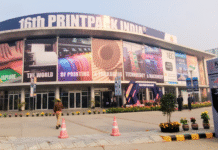
The Indian Printers Summit 2022, Wan-Ifra’s much-awaited annual event in India for business and technology managers, began on 14 September with an air of optimism, staying true to this year’s theme, ‘Back to business – Print for the Future.’
The two-day conference, which is being held at Radisson Blu Plaza Delhi Airport, was an in-person event that centered on the new challenges and opportunities for the print media industry in a post-Covid world that has largely shifted to digital during the pandemic.
‘Print is not dead yet, long live print’ was the general refrain of the speakers and delegates, who felt that the decent attendance – coupled with the fact that the event was held physically after a hiatus – were proof enough that the medium was here to stay, and how.
The print media was one of the worst-hit industries during the Covid-19 pandemic with circulation and revenue plummeting to unprecedented levels, editions being shut down and employees being laid off en masse. But as the economy opens up and the advertisers loosen their purse strings, there is a sense of optimism seen among the attendees.
In his inaugural address, KN Shanth Kumar, director, of The Printers Mysore (publishers of the dailies’ Deccan Herald and Prajavani and several other publications), and member of the board of Wan-Ifra, said the strong response to the event overrode all the initial apprehension about the conference when the planning began eight or nine months ago.
The print news media is not done yet!
Kumar, while admitting the rise of digital, said the print media was not done yet because it was slowly but gradually coming back to normal, despite the challenges of newsprint prices, and circulation and revenue declines. “Things are looking up, ads are back and the results are encouraging,” Kumar said, adding it was time to take stock, adapt to the new realities, and plan for the future.
Welcoming the delegates, Adrian Haack, director, Konrad Adenauer Foundation, Delhi, dwelt at length about the changing and reducing attention patterns of news consumers, the debate on which is better – social or classical media – the importance of fact-checking in an era of fake news, and the nuances of language in shaping opinions; drawing the example of the war in Ukraine.
Mohit Jain, board member and executive director, Bennet Coleman, and Co, in his opening keynote, and Partha Sinha, president (Response) of the same group, harped on the credibility, heritage, legacy, recall value, strong content, and personal touch of print media vis a vis digital, saying these factors would ensure the survival of the medium and draw advertisers again.
Jain, who is also the INS president and a board member of Wan-Infra, said the new business cohorts and unicorns hold a great opportunity for the print media that can and should find ways and means to collaborate with these rising segments. “Just as TV didn’t kill radio and OTT didn’t kill cinema, digital cannot kill print,” he said.
Sinha, speaking along similar lines, gave an analogy of football and cricket to buttress his point. Just as someone good at cricket cannot shift to football because someone else is playing it, print has its strength and has to repurpose it to fit the new order, he stressed. Sinha compared the effectiveness of advertisements in the two mediums and explained how print scores over digital. And this aspect of brand safety and brand authenticity needs to be told to advertisers, he said. But at the same time, he cautioned that this doesn’t mean digital is the bad guy in town, emphasizing the need for both mediums to coexist.
Citing research, Sinha said that digital advertising is best for short term sales activation, while for long term brand building, print advertising is shown to be the most effective. He suggested that the most desirable ratio of ad spend is 40/60 with 40% on digital and 60% for print. “In fact since short term digital activation is becoming more efficient even less budget is needed there,” he asserted.

Photo IPP
The addresses were followed by a roundtable on the theme, ‘Post pandemic revival and the ensuing business opportunities,’ during which Suresh Balakrishna, chief revenue officer of The Hindu, Harrish M Bhatia, president, ad sales, DB Corp, and Varghese Chandy, vice-president, marketing and advertising sales, Malayala Manorama, spoke about the organic slowdown of print before Covid, its revival, the loss and gain of advertisers, and how print can stay relevant and profitable amid the changing dynamics of business and content as well the trust and legacy factors.
All three participants were unanimous in their positive outlook for the print media industry given that business was back to 2019 levels and was looking ahead to growth. They spoke about the need to target the new generation that grew up with digital and educate them about the USPs of print as well as look out for new sets of local and non-traditional advertisers.
Balakrishna concluded the session with a word of caution over what he called the over-hype of digital, and called for a balance, saying the print media was still the bread, butter, and everything for the big and legacy publishing houses – which says a lot about its relevance.
The day 1 session, which was attended by CEOs, managing directors, technical directors, production heads, plant managers, prepress managers, and other senior news publishing leaders, ended with the recognition of the numerous International Color Quality Club (ICQC) winners from India who seem to have now surpassed Germany as the country with most publications admitted to these honors acknowledging their prowess in color news media production.
This article has been slightly amended for added information on 17 September 2022.















